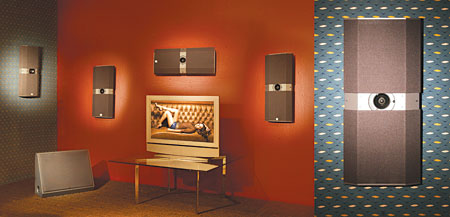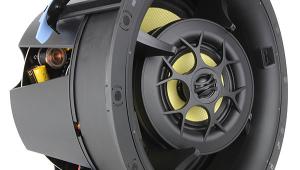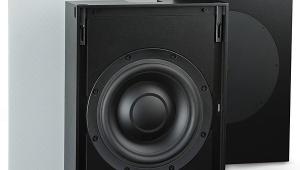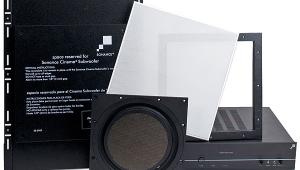Morel Vario On-Wall Speaker System
Released from the boxes of thousands upon thousands of plasma and LCD TVs was a nasty disease that's induced feverish thoughts of flatness and smallness in the minds of otherwise good and decent people, making them forget how important audio is to a home theater system. (That rumbling sound is Paul Klipsch rolling over in his grave.) For these poor, deluded folks, speakers are not much more than a flat-panel-TV accessory.

Such is the stuff that nightmares are made of. I thought that those of us in the decadent West had hit rock bottom with the $4 decaf nonfat latte, but, obviously, I was wrong. Now we're envisioning speakers as accouterments for TVs. The next thing you know, we'll think watching movies streamed to tiny-screen cell phones will be the height of coolness.
Who the Morel Do They Think They Are?
Some speaker makers choose to ignore the trend—and the potential sales. Others fill a niche by forsaking appearances (and, in most cases, sales) for performance. The greedy build a pretty box, stuff it with fluff, and wait for the orders to roll in. The manufacturers who care about sound quality but would also like to make a buck or two take the extra time and effort to design something for both the people who want good looks (the silent majority) and those who want great sound.
All of this leads us to Morel, a 30-plus-year-old speaker manufacturer you may not have heard of—but one that's built tweeters and woofers for lots of loudspeaker companies you have heard of. Morel also makes their own brand of speakers, and, several years ago, I had the chance to review Morel's SoundSpot SA-2 sub/sat system. It was obvious from the SA-2 satellites' sound and the unique spherical design that Morel was serious about both performance and appearance. While the SoundSpot systems are perfect for flanking a flat-panel TV because they fit the smaller-is-better aesthetic (without sacrificing performance), Morel's Vario on-walls are designed to appeal to the more perspicacious home theater owner who wants speakers that look nice but can knock his socks off when he wants them to.
It's a Bit of a Stretch
Pity the poor speaker engineer who wants to design speakers that will aesthetically match most of the flat-panel TVs on the market. It's simply impossible to make enough speaker models that either match the TVs' dimensions exactly (for the obsessive-compulsive crowd) or maintain an appealing speaker-to-TV-size ratio (for the golden-mean devotees). When a speaker company does decide to offer more than one on-wall model, the bigger one is often the better-sounding one. That's the way it is with more than a few manufacturers of traditional freestanding speakers, too. In this case, though, the guy who wants better sound but owns a smaller flat-panel TV gets the short end of the sound stick.
Morel has a smart solution to the size/performance problem. The Vario is designed in such a way that it can be as short as 23.75 inches tall (or wide, if mounted horizontally) or as long as 40.25 inches—or any length in between. In other words, you can mount the same Vario next to a 32-inch LCD TV or a 63-inch plasma, and it will still look as if it were designed specifically for that particular model. Of course, it'll work just as well with the intermediate sizes, too.
The trick to this one-size-fits-almost-all magic is a grilles-behind-a-grille design. In its smallest form, the Vario's main grille covers the front of the entire speaker. Beneath that grille, however, are two nearly half-height grilles (when looking at the speaker mounted vertically), each one attached to an end cap. To make the speaker longer, pull each of the end caps away from the center of the speaker. Once you've achieved the proper length, tighten the two set screws under the main grille to lock the extended grilles in place. To the uninitiated, the whole thing looks like one long, impressive speaker—but it sounds almost the same regardless of its length. The technique, by the way, also works for matching the width of a TV when you mount the speaker horizontally as a center channel.
You have to take care to align the grille segments properly, however, or they'll look a little like a crooked picture frame that you always want to nudge one way or the other. (A good installer ought to be able to make sure that won't happen.) Personally, I wish Morel had chosen to make the front grille wrap around the speaker on each side—as the extending grilles do—so that the cabinet's side walls don't show when the underlying grilles are extended. The cabinet has a quality finish, but my preference in this case would be that it simply not show at all.
Built Like a Brick
Although the Vario isn't the smallest on-wall in the world, its modest size is deceiving when it comes time to lift all 36 pounds of it. Evidently, the internal cabinet bracing is braced with bracing, because these speakers seem about as dense as a block of concrete. Each speaker uses a pair of 5.25-inch Morel woofers utilizing 3-inch voice coils and a special double-magnet motor system that Morel says is four times smaller than a conventional loudspeaker motor with the same power. Complementing the pair of woofers is a single, 1.125-inch soft dome tweeter.
The Variosub isn't size-adjustable like the on-wall, but it's unusual in its own way. The cabinet is a triangular prism (two triangular bases and three rectangular sides) with a 10-inch woofer mounted on one of the rectangular sides. The back-panel jacks and the heat sinks that cool the 200-watt internal amplifier are mounted on a second rectangular side, while the port is on the third rectangular side. The unique prism shape allows you to use the subwoofer standing upright or position it lying down.

A Couple of Mellow Fellows
In my experience, it's darn near always a good thing when you put together a system using identical speakers for all of the channels. That automatically gives the Vario system an edge in my mind when it comes to multichannel sources. But it's with two-channel music that you'll come to realize how mellow these speakers are. When I say mellow, I don't mean in a sunglasses-on, hey-man, ganja-smoke-filled-room kind of way, either. The experience is more of a cream-cheese-stuffed-jalapeno, man-this-tastes-good sensation in that moment just before your tongue spontaneously combusts. The Vario speakers are smooth and sweet but can also create some impressive fireworks.
Ray Brown's rendition of "Sweet Georgia Brown" (Soular Energy) is one of those sweet and mellow cuts in which the laid-back mood oozes out of the Varios without any softening of the sharp piano notes and bass-string picks—and, all the while, the Variosub and the on-walls played as if they were one tightly integrated system. While you can't say there's much multichannel mellowness in Pink Floyd's The Wall, the Varios could definitely keep pace with the clocks and other sound effects without displaying any harshness, even at louder volumes. I was especially impressed with 3 Doors Down's Away From the Sun SuperDisc DVD (Monster Music), from the standpoint of the vocals and music, as well as the smooth and easy transition of applause from the front to the rear.
In The Chronicles of Narnia, when the beavers are leading the children across the rapidly melting frozen river, the Varios wonderfully reproduced the rich, gravelly rumble of the head wolf's voice. But it was the performance of the whole system together that really stood out later in the scene when the ice flow begins to break away and the wall of ice behind the characters begins to crack and rumble just before it collapses. The children's voices were always clear in the center Vario, as was the music in the left and right speakers within the midst of all the surrounding effects.
Good and Good for You
On-wall speakers, like their wall-hugging flat-panel video companions, have improved significantly over the last five or six years, so it's no longer a surprise to find a system that sounds good. But Morel's Varios are more than just good. They sound outstandingly good and are well worth the sticker price—and then some—whether it's $2,000 for a stereo pair or six grand for a 5.1-channel system. I wasn't the only one who was impressed by the speakers, either. One of my sons—the one who rarely comments on any of the gear that finds its way through our living room other than to complain about something being too complicated to operate—breezed by while I was taking the Varios off of the wall. When he surprisingly took the time to stop and ask if the speakers were going back, I knew they'd hit a chord with him—as they did with me. In fact, the system performs so well, you'll probably think of your plasma TV (no matter what size you own) as an accessory to the Varios rather than the other way around. But, if you want a Vario system just because it'll look good with your flat panel, that's OK, too.
Highlights
• The length of the grille is adjustable to match the height or width of your display
• The subwoofer's unique cabinet shape makes it easy to conceal
• The on-wall's performance rivals that of floorstanding models





























































